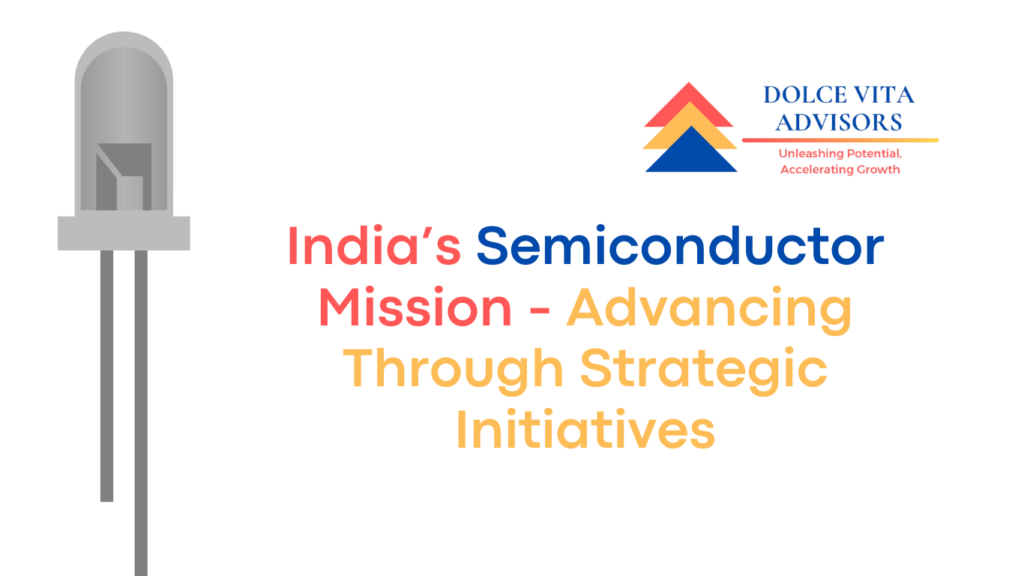
Insights by: Sumit Kochar
In recent years, the semiconductor industry has witnessed substantial growth, propelled by influential factors such as the widespread adoption of wireless technologies, increased demand for processing units driven by cryptocurrency mining, and governmental initiatives towards digitalization. Drawing crucial lessons from the challenges posed by the pandemic, the industry is actively engaged in developing strategies to mitigate the impact of unforeseen events.
Geopolitical tensions, particularly between the United States and China, have contributed to a supply shortage, given China’s significant position as a major chip manufacturer. Against this backdrop, the Indian semiconductor market, currently valued at approximately $23.2 billion, is anticipated to reach $80.3 billion by 2028, demonstrating a compound annual growth rate (CAGR) of 17.10%.
India, with its substantial population and robust education system, stands poised to emerge as a talent powerhouse in the semiconductor industry, offering a viable solution to the acute shortage of skilled professionals. Several measures and policies, including the ‘Make in India’ initiative launched in 2014, are designed to bolster manufacturing and establish India as a global manufacturing hub. Initiatives like the Production Linked Incentive (PLI) scheme for the electronics sector offer a groundbreaking $1.7 billion incentive package for companies establishing semiconductor manufacturing facilities in India, generating both direct and indirect employment opportunities.
Before the onset of the COVID-19 pandemic and the Russian invasion of Ukraine, the semiconductor industry was primarily dominated by a few countries like United States of America, Taiwan and China. However, since the second quarter of 2020, the global industry has grappled with a severe chip shortage. This scarcity intensified due to the expansion of the work-from-home paradigm and the exponential surge in demand for tech products. Supply constraints were further exacerbated by frequent lockdowns in South Asian nations engaged in downstream processes such as testing and packing, resulting in supply-side bottlenecks. Concurrently, the incentives provided by governments have spurred an escalating demand for electric automobiles, placing an additional burden on the system, as each new vehicle requires approximately 300 unique chips.
Consequently, the escalating global demand for semiconductor chips has presented a notable economic opportunity for India, leading to the establishment of the India Semiconductor Mission (ISM).
India Semiconductor Mission
The ISM, inaugurated in 2021 with a substantial financial outlay of Rs. 76,000 crore, operates under the auspices of the Ministry of Electronics and IT (MeitY). This mission constitutes a pivotal element within a comprehensive program designed to foster the sustainable growth of the semiconductor and display ecosystem within the nation.
The primary objective of the ISM is to extend financial support to companies engaged in investments within the semiconductor, display manufacturing, and design sectors. Positioned to be steered by global experts in the Semiconductor and Display industry, the ISM is envisioned as the central agency for the efficient, coherent, and seamless implementation of its outlined schemes.
The key components of the ISM encompass schemes tailored to specific facets of the semiconductor and display industry:
- Scheme for setting up Semiconductor Fabs in India: This initiative furnishes fiscal support to eligible applicants committed to establishing Semiconductor Fabs. The aim is to attract substantial investments for the creation of semiconductor wafer fabrication facilities within the country.
- Scheme for setting up Display Fabs in India: Geared towards attracting significant investments, this scheme provides fiscal support to eligible applicants for establishing Display Fabs, focusing on TFT LCD / AMOLED based display fabrication facilities within India.
- Scheme for setting up Compound Semiconductors / Silicon Photonics / Sensors Fab and Semiconductor Assembly, Testing, Marking and Packaging (ATMP) / OSAT facilities in India: Offering fiscal support amounting to 30% of the Capital Expenditure, this scheme targets the establishment of Compound Semiconductors / Silicon Photonics (SiPh) / Sensors (including MEMS) Fab and Semiconductor ATMP / OSAT (Outsourced Semiconductor Assembly and Test) facilities within the country.
- Design Linked Incentive (DLI) Scheme: This scheme provides financial incentives and design infrastructure support across various developmental stages of semiconductor design, including Integrated Circuits (ICs), Chipsets, System on Chips (SoCs), Systems & IP Cores, and semiconductor-linked designs.
The overarching vision of the ISM is to cultivate a vibrant semiconductor and display design and innovation ecosystem, positioning India as a global hub for electronics manufacturing and design.
The ISM assumes paramount importance in orchestrating concerted efforts to promote the semiconductor and display industry in a structured, focused, and comprehensive manner. It is poised to formulate a comprehensive long-term strategy for the development of semiconductor and display manufacturing facilities and the semiconductor design ecosystem in India.
Moreover, the ISM is expected to facilitate the adoption of trusted electronics through secure semiconductor and display supply chains, encompassing raw materials, specialty chemicals, gases, and manufacturing equipment. It is anticipated to drive a multi-fold growth of the Indian semiconductor design industry by providing crucial support, such as Electronic Design Automation (EDA) tools and foundry services, particularly for early-stage startups.
Additionally, the mission is geared towards promoting and facilitating indigenous Intellectual Property (IP) generation while encouraging, enabling, and incentivizing the Transfer of Technologies (ToT). Through collaborations and partnership programs with national and international agencies, industries, and institutions, the ISM aims to catalyze collaborative research, commercialization, and skill development within the semiconductor and display sectors.
Significance of ISM
India’s greatest asset lies in its highly skilled workforce, with Indian engineers constituting approximately 20% of the world’s semiconductor design workforce. To ensure a skilled workforce for the future, the government has introduced programs and curriculum changes, with industry participation being crucial for enhancing and supporting the talent pool.
Foreign interest in India’s Semiconductor Mission is evident through significant investments by leading American semiconductor companies. Micron Technology, for instance, plans to invest over $800 million in constructing a new semiconductor assembly and test facility in Gujarat, India. This move is expected to reshape India’s semiconductor landscape and create numerous high-tech and construction jobs.
Applied Materials and Lam Research Corporation have also shown interest in establishing collaborative centres in India, contributing to talent development and furthering India’s role in the global chip ecosystem. The collaboration between India and the United States aims to strengthen semiconductor supply chains and enhance resilience and diversification.
Recently on February 29, 2024, the Union Cabinet, presided over by Prime Minister Shri Narendra Modi, has given its nod for the establishment of three semiconductor units, marking a significant leap in India’s pursuit of self-reliance in semiconductor production. The ambitious “Development of Semiconductors and Display Manufacturing Ecosystems in India” initiative, with a substantial outlay of Rs. 76,000 crore, was officially sanctioned on December 21, 2021. Notably, this approval follows the Union Cabinet’s earlier green light in June 2023 for Micron’s semiconductor unit in Sanand, Gujarat, which is currently progressing swiftly, contributing to the emergence of a robust semiconductor ecosystem in the region.
The three approved semiconductor units are poised to play pivotal roles in advancing India’s semiconductor capabilities:
- Semiconductor Fab with 50,000 wfsm Capacity: Tata Electronics Private Limited (“TEPL”) is set to collaborate with Powerchip Semiconductor Manufacturing Corp (PSMC), Taiwan, in establishing a semiconductor fab. This facility, located in Dholera, Gujarat, will see an investment of Rs. 91,000 crore. PSMC, renowned for its expertise in logic and memory foundry segments, will contribute to the development of high-performance computing chips with 28 nm technology and power management chips for various applications, including electric vehicles, telecom, defence, automotive, consumer electronics, display, and power electronics.
- Semiconductor ATMP Unit in Assam: Tata Semiconductor Assembly and Test Pvt Ltd (“TSAT”) will establish a semiconductor unit in Morigaon, Assam, with an investment of Rs. 27,000 crore. This unit will focus on the development of indigenous advanced semiconductor packaging technologies, including flip chip and ISIP (integrated system in package) technologies. The facility’s capacity is set at 48 million units per day, covering segments such as automotive, electric vehicles, consumer electronics, telecom, and mobile phones.
- Semiconductor ATMP Unit for Specialized Chips: CG Power, in collaboration with Renesas Electronics Corporation, Japan, and Stars Microelectronics, Thailand, will set up a semiconductor unit in Sanand, Gujarat, with an investment of Rs. 7,600 crore. Renesas, a leading semiconductor company specializing in microcontrollers, analog, power, and System on Chip (‘SoC)’ products, will be the technology partner. This unit aims to manufacture specialized chips for consumer, industrial, automotive, and power applications, with a daily capacity of 15 million units.
The strategic significance of these units lies in their contribution to the India Semiconductor Mission. They will foster the establishment of a robust semiconductor ecosystem in the country, building upon existing capabilities in chip design and facilitating the development of chip fabrication capabilities. Moreover, the indigenous development of advanced packaging technologies underscores India’s growing prowess in the semiconductor industry.
In terms of employment potential, these units are expected to generate 20 thousand direct advanced technology jobs and approximately 60 thousand indirect jobs. This initiative is poised to expedite employment creation across downstream sectors such as automotive, electronics manufacturing, telecom manufacturing, industrial manufacturing, and other semiconductor-consuming industries.
Conclusion
India’s semiconductor industry is poised for substantial growth driven by strategic initiatives and visionary policies, notably the “Development of Semiconductors and Display Manufacturing Ecosystems in India” initiative under Prime Minister Shri Narendra Modi’s leadership. With a robust financial outlay of Rs. 76,000 crore, the India Semiconductor Mission reflects the government’s commitment to fostering self-reliance and innovation in the semiconductor sector. The recent approvals for three significant semiconductor units, strategically located across Gujarat and Assam, show India’s determination to meet domestic demand and contribute significantly to global semiconductor supply chains. Prime Minister Shri Narendra Modi’s collaborative efforts with leading international semiconductor companies and his promotion of policies like ‘Make in India’ and the PLI scheme for electronics have positioned India as an attractive destination for semiconductor manufacturing and research. The successful implementation of the India Semiconductor Mission, coupled with the indigenous development of advanced technologies, is expected to generate a substantial number of direct and indirect jobs while reinforcing India’s status as a global hub for electronics manufacturing and design. Prime Minister Narendra Modi’s visionary leadership in steering this transformative mission deserves commendation, marking a significant stride towards a self-reliant and technologically empowered India.

